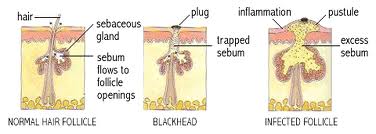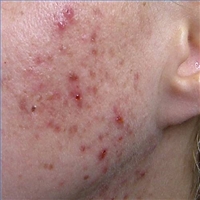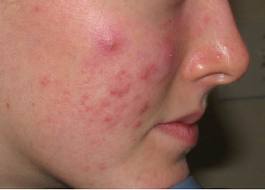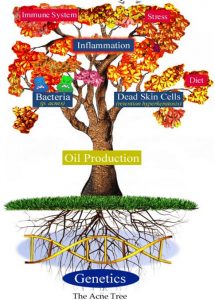Acne, a chronic inflammatory skin disorder of the sebaceous glands characterized by comedones and blemishes, and is often a hereditary trait which is also triggered by hormonal changes.
Acne is caused by physical changes in the sebaceous follicles (oil glands) and develops through several stages. Initially a sebaceous follicle gets plugged with sebum (skin oil) and dead cells from the inside the follicle forming a comedo (or a plug).
When a comedo is open and visible it is often called a blackhead because of its blackish appearance. A closed comedo is often called a whitehead (a small skin colored bump).
Blackheads and whiteheads can turn into nodules, solid and irregular shaped lesions, characterized by inflammation and pain. If the nodule gets infected it turns into a cyst, a sac-like lesion containing liquid or semi-liquid pus.
 Acne can be very resistant and
often requires time to resolve. Even after acne resolves or improves,
continued treatment is recommended to prevent reoccurence.
Acne can be very resistant and
often requires time to resolve. Even after acne resolves or improves,
continued treatment is recommended to prevent reoccurence.
Bacteria in the follicles are anaerobic. This means they cannot live in the presence of oxygen. When follicles are blocked with sebum and dead skin build-up, oxygen cannot reach the bottom of the follicle, resulting in bacteria growth.
Adult acne is often caused by the overproduction of sebum, an oil created by the skin’s sebaceous glands. It travels up hair follicles to the surface of your skin to act as a lubricant for the hair and skin.
When excess sebum is produced, it can mix with dead skin cells to clog pores, trapping bacteria underneath.
Pimples occur when the trapped bacteria cause inflammation or infection within the blocked pore. (source: Mayo Clinic).
For some adults, breakouts are a result of hypersensitivity or overproduction of androgens (male hormones). But an imbalance in both male and female hormones (estrogen) can also cause breakouts.
Acne Rosacea features all of the conditions found in rosacea, in addition to presence of papules, pustules, and, in some cases, the fosteringof parasitic microorganisms (mites). While these may resemble acne, blackheads are absent and burning or stinging may occur.
The adolescent mite dermatitis and early symptoms of rosacea are frequently misdiagnosed as adolescent acne. 90% of the adults and teenagers acne is caused by Demodex mites, 10% is bacterial.


The change of the hormones makes the sebaceous glands produce more sebum, making the facial skin a perfect living and breeding place, they can now easily multiply and this is translated in infections and acne. (source: Demodexsolutions.com)
The cause of acne is actually toxins and wastes that build up inside the body that cannot be properly eliminated. The body has several “normal” methods for expelling these toxins, through the liver, kidneys, colon, small intestine, and other organs.
However, if any of these organs are weak and can’t handle the load, or if the buildup is too great or too rapid, acne can results.
If one suffers from acne it is the body’s way of saying that there is a toxic build-up which the liver is unable to clean and the skin shows the imbalance.
One can start by easing the load of the liver by drinking lots of water, eating a balanced diet and regular exercise. Regular saunas and steambaths help to flush out toxins from the body.
Acne triggers:
Hormonal changes: Menstruation, pregnancy, time of menses or menopause, oral contraceptives and emotional stress lead to hormone changes which can induce skin breakouts. Abnormal hormonal imbalance can trigger sebaceous glands to secrete too much oil. The oil clogs pores, bacteria arrive, inflammation occurs and acne appears.
Genes: Acne can be hereditary. A child whose parents have acne is more likely to be affected by acne also.
Candida/yeast overgrowth: The balance between good bacteria and yeast is very important because if this balance becomes unbalanced (due to things like stress, alcohol, chronic antibiotics use, nicotine, tap water, parasites, hormonal imbalance, drugs and medication) then the Candida is allowed to flourish and grow out of control making you sick.
Stress: Stress triggers the body to produce certain hormones and increases the levels of harmful toxins in the body that can aggravate acne. Get sufficient sleep, regular exercise and clean your skin from within.

Foods: Excessive iodine in salt, MSG, kelp, cheese, processed and packaged foods especially fast foods and minerals obtained from an ocean source in vitamins, can irritate acne.

Eating fresh vegetables and fruits, almonds, walnuts, pumpkin seeds, fresh cold-water fish, flaxseed oil (omega-3 fatty acids), herbal teas and increasing water intake seem to help those with acne experience fewer breakouts.
Avoid: Sugar,chocolate, junk food, and salt. Reduce the amount of fat in your diet (pork, fried and highly seasoned foods).
- Do not drink soft drinks or alcoholic beverages.
- Do not smoke. Smoking promotes enlargement of the pores.
Medication: Some medications that contain drugs like Bromides, Lithium, Corticosteroids, and etc. have been proven to trigger acne. Certain birth control drugs (those that contain only progestins) can also interfere with hormonal production.
Pressure or friction from rubbing or touching the face, phone use, or wearing hats can contribute to acne breakouts. Dirty pillows or makeup brushes can also transfer bacteria to the face.
Environmental factors: Pollution, humidity, and the sun can all affect the skin negatively and provoke an acne problem.
Personal care products: Oily lotions, sunscreens or hair products can aggravate acne.
Untreated acne can leave scars.
Our Treatments
At Svetlana’s Skin Secrets we offer a personalized approach in treatment recommendations, that takes into regard your lifestyle and diet, which could be having an impact on your acne:

